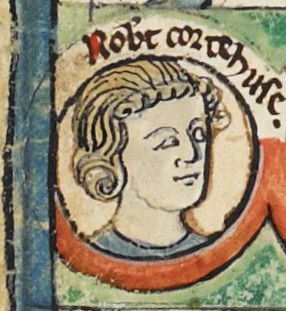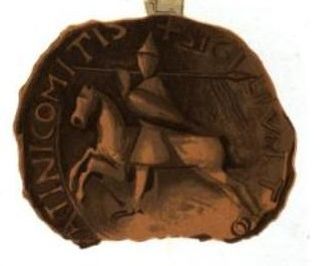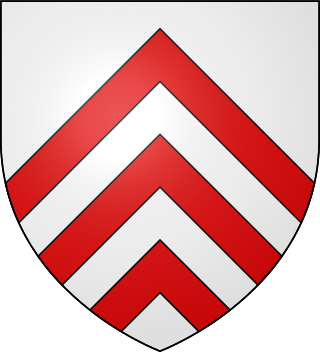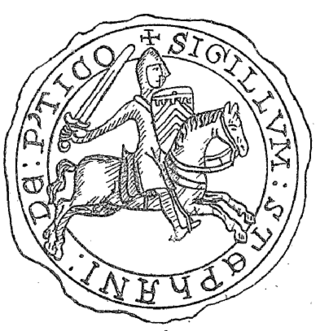
Henry I, also known as Henry Beauclerc, was King of England from 1100 to his death in 1135. He was the fourth son of William the Conqueror and was educated in Latin and the liberal arts. On William's death in 1087, Henry's elder brothers Robert Curthose and William Rufus inherited Normandy and England, respectively, but Henry was left landless. He purchased the County of Cotentin in western Normandy from Robert, but his brothers deposed him in 1091. He gradually rebuilt his power base in the Cotentin and allied himself with William Rufus against Robert.

Philip II, byname Philip Augustus, was King of France from 1180 to 1223. His predecessors had been known as kings of the Franks, but from 1190 onward, Philip became the first French monarch to style himself "King of France". The son of King Louis VII and his third wife, Adela of Champagne, he was originally nicknamed Dieudonné (God-given) because he was a first son and born late in his father's life. Philip was given the epithet "Augustus" by the chronicler Rigord for having extended the crown lands of France so remarkably.

Robert Curthose, or Robert II of Normandy, was the eldest son of William the Conqueror and succeeded his father as Duke of Normandy in 1087, reigning until 1106. Robert was also an unsuccessful claimant to the throne of the Kingdom of England. The epithet "Curthose" had its origins in the Norman French word courtheuse 'short stockings' and was apparently derived from a nickname given to Robert by his father; the chroniclers William of Malmesbury and Orderic Vitalis reported that William the Conqueror had derisively called Robert brevis-ocrea.

Geoffrey V, called the Handsome, the Fair or Plantagenet, was the Count of Anjou, Touraine and Maine by inheritance from 1129, and also Duke of Normandy by conquest from 1144. His marriage to Empress Matilda, daughter of King Henry I of England, led to the centuries-long reign of the Plantagenet dynasty in England. The name "Plantagenet" was taken from Geoffrey's epithet. Geoffrey's ancestral domain of Anjou gave rise to the name Angevin, and what modern historians name as the Angevin Empire in the 12th century.
William de Mandeville, 3rd Earl of Essex was a loyal councillor of Henry II and Richard I of England.
Philip I, commonly known as Philip of Alsace, was count of Flanders from 1168 to 1191. During his rule Flanders prospered economically. He took part in two crusades and died of disease in the Holy Land.

Theobald the Great (1090–1152) was count of Blois and of Chartres as Theobald IV from 1102 and was Count of Champagne and of Brie as Theobald II from 1125. Theobald held Auxerre, Maligny, Ervy, Troyes and Châteauvillain as fiefs from Odo II, Duke of Burgundy.

The term Angevin Empire describes the possessions of the House of Plantagenet during the 12th and 13th centuries, when they ruled over an area covering roughly half of France, all of England, and parts of Ireland and Wales, and had further influence over much of the remaining British Isles. It may be described as an early example of a composite monarchy. The empire was established by Henry II of England, who succeeded his father Geoffrey Plantagenet as Duke of Normandy and Count of Anjou. Henry married Eleanor of Aquitaine in 1152, becoming her royal consort, and inherited his mother Empress Matilda's claim to the English throne, succeeding his rival Stephen in 1154. Although their title of highest rank came from the Kingdom of England, the Plantagenets held court primarily on the continent at Angers in Anjou, and at Chinon in Touraine.
William IV Talvas was William III, Count of Ponthieu and William IV. He was Count of Ponthieu, ruler of a small province in northern France that fell under the suzerainty of the dukes of Normandy since at least the mid 11th century. He was son and heir of John I, Count of Ponthieu by his third wife Beatrice de St Pol.

Theobald V of Blois, also known as Theobald the Good, was Count of Blois from 1151 to 1191.

The county of Perche was a medieval county lying between Normandy and Maine.

William FitzEmpress or William Longespee was the youngest of the three sons of Empress Matilda and Geoffrey Plantagenet, Count of Anjou. His brothers were Henry II of England and Geoffrey, Count of Nantes.
The l'Aigle family was a Norman family that derived from the town of L'Aigle, on the southeastern borders of the Duchy of Normandy. They first appear during the rule of Duke Richard II of Normandy, in the early 11th century, and they would hold L'Aigle for the Norman Dukes and Kings of England until the first half of the 13th century, when with the fall of Normandy to the French crown the last of the line was forced to abandon the ancestral French lands, only to die in England a few years later without surviving English heirs. Their position on the borderlands, and near the headwaters of three rivers, the Risle, Iton and Avre, gave their small holding a special importance, as did a set of marriage connections that provided this relatively minor Norman noble family with a more elevated historical visibility. Having been neighbors and benefactors of the Abbey of Saint-Evroul, the family receive mostly favourable coverage in the 12th-century chronicle of Orderic Vitalis.

Rotrou III, called the Great, was the Count of Perche and Mortagne from 1099. He was the son of Geoffrey II, Count of Perche, and Beatrix de Ramerupt, daughter of Hilduin IV, Count of Montdidier. He was a notable Crusader and a participant in the Reconquista in eastern Spain, even ruling the city of Tudela in Navarre from 1123 to 1131. He is commonly credited with introducing Arabian horses to the Perche, giving rise to the Percheron breed. By his creation of a monastery at La Trappe in memory of his wife, Matilda, daughter of Henry I of England, in 1122 he also laid the foundations of the later Trappists.

The Angevins were a royal house of Anglo-French origin that ruled England and France in the 12th and early 13th centuries; its monarchs were Henry II, Richard I and John. The Anglo-French Henry II, won control of a vast assemblage of lands in western Europe that would last for 80 years and would retrospectively be referred to as the Angevin Empire. As a political entity this was structurally different from the preceding Norman and subsequent Plantagenet realms. Geoffrey became Duke of Normandy in 1144 and died in 1151. In 1152, his heir, Henry, added Aquitaine by virtue of his marriage to Eleanor of Aquitaine. Henry also inherited the claim of his mother, Empress Matilda, the daughter of King Henry I and the Anglo-Saxon princess Edith-Matilda, from the house of Wessex, to the English throne, to which he succeeded in 1154 following the death of King Stephen.
Matilda of Saxony, or Richenza of Saxony was the Countess of Perche followed by the title of Lady of Coucy from the German Welf dynasty. She was also the niece of Richard the Lionheart.
Rotrou IV (1135-1191), was the Count of Perche. He joined Louis VII of France in a war against Henry II of England, in which he lost lands to the English. Rotrou later went on crusade with Philip II of France and died after the Siege of Acre in 1191.
Thomas, Count of Perche, was the son of Geoffrey III, Count of Perche, and Matilda of Saxony, daughter of Henry the Lion, Duke of Saxony and Bavaria, and Matilda of England. He died young.

Stephen du Perche was a French nobleman and crusader. He was a partisan of the Plantagenets in their conflict with the French crown and held fiefs from them. A younger son, he governed the County of Perche on behalf of his father and brother during their absence on crusade. He himself joined the Fourth Crusade in 1202 and travelled to the Holy Land. Afterwards, he went to the Latin Empire and was appointed duke of Philadelphia in Asia Minor in 1204. He died in battle against the Bulgars.
Thierry of Flanders was a Flemish nobleman and crusader active in 1197–1207.












